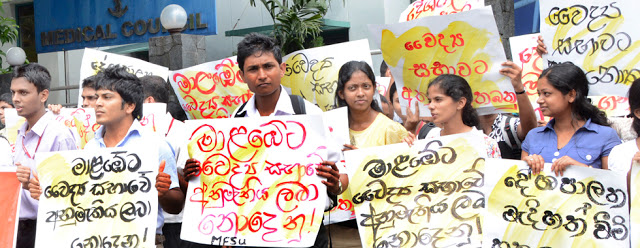A Brief Colonial History Of Ceylon(SriLanka)
Sri Lanka: One Island Two Nations
A Brief Colonial History Of Ceylon(SriLanka)
Sri Lanka: One Island Two Nations
(Full Story)
Search This Blog
Back to 500BC.
==========================
Thiranjala Weerasinghe sj.- One Island Two Nations
?????????????????????????????????????????????????Monday, August 7, 2017
SAITM As Model For Expanding Medical Education?
By
Sumathy Sivamohan, Harini Amarasuriya, A. Karunatileke, Athula
Samarakoon, Upul Wickramasinghe, Waradas Thiyagarajah, Chinthaka
Rajapakse, Shamila Ratnasuriya, S.Thanujan, M.Mauran, Amali Wedegedera,
Niyanthini Kadirgamar and Sylvester Jayakody –AUGUST 5, 2017
 A Response to the Subcommittee on Higher Education of the Parliamentary Sectoral Oversight Committee
A Response to the Subcommittee on Higher Education of the Parliamentary Sectoral Oversight Committee
On
the 1st of August, concerned Academics and Activists gathered at the
Honourable Speaker, Karu Jayasuriya’s office in the parliament and
handed over a response to the report on SAITM made by a sub-committee of the Oversight Committee on Education and Human Resources. Copies
of the report to be given all the members of the Oversight Committee,
Prime Minister, Leader of the Opposition, Government Whip, Opposition
Whip and the Minister of Higher Education and Highways were also handed
over to the Hon. Speaker. 

SAITM: An ill-conceived response to the question of health and education in Sri Lanka
The
government appears ill prepared to address the unravelling situation
around SAITM. Its current actions are mired in violence, bombastic
rhetoric and unrealistic projections of great economic advances to be
made in the business of education and health. The policy paper of the
Subcommittee on Higher Education of the Parliamentary Sectoral Oversight
Committee, Expansion of Medical Education in Sri Lanka With the Participation of the Private Sector: Adopting the South Asian Institute of Technology and Medicine (SAITM) as a Model published on 23 November, 2016 is a justification and conceptualisation of SAITM
as an educational institution, offering it as a panacea for the
supposed ills dogging the heels of the two sectors. It is an
illustration of the nature of the government’s approach to some very
serious issues, undertaken in an ad hoc, unprofessional and unethical
manner. The ill-conceived nature of the report unequivocally
demonstrates the fact that SAITM is itself a poorly planned programme
that barely addresses the problems that exist in the areas of health and
education and creates new ones that will be insurmountable in years to
come.
Both health and education have been the cornerstone of the democratic structure of the Sri Lankan state. A
policy shift on either of these sectors demands careful thought, public
engagement, and the highest degree of integrity on the part of all the
policy makers. Yet on both counts, the policy paper demonstrates
abjectly poor thinking and a clear lack of vision for the country.
SAITM: Is it numbers?
Regarding
Health, the paper says that SAITM will address the lacunae in the
system presented by the inadequate number of doctors in the country. In
other words, SAITM will be able to add to the number of doctors in the
country. Such a claim, if stated with any sincerity, demonstrates that
the policy makers have absolutely no understanding of the existing
system of health care delivery. The problems besetting the health sector
are not a mere matter of numbers. They are an integral part of the
structure of health care provision, namely distribution and
specialization. As medical professionals, researchers and those who
actually care about the state of affairs in Sri Lanka will tell you:
a)
The inadequate number of medical professionals lies in the areas of
distribution of doctors across the country. In 2015, Colombo District
had 182.3 doctors per 100,000 population (employed by the Ministry of
Health) compared with 37 doctors per 100,000 population in Nuwara Eliya
District (Vallipuranathan 2017).
That same year, Colombo District recorded the highest number of medical
officers (5344), while the lowest number was recorded in Mullaitivu
District (Health Information Unit, Ministry of Health 2015).
b)
Doctors on completing their internship are posted to peripheral areas,
but can leave those stations before they are eligible for transfer if
they pass a screening exam for a course of specialization. There is no
mechanism in place to retain non-specialist doctors in such areas,
resulting in a large number of cadre positions remaining vacant.

